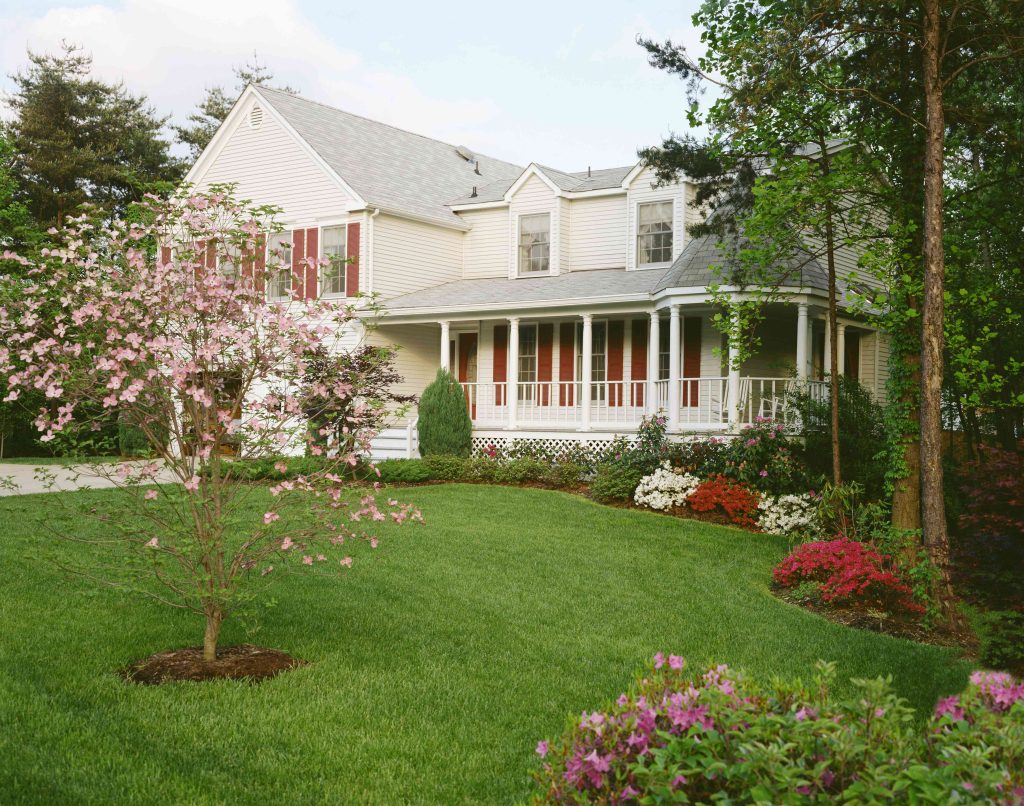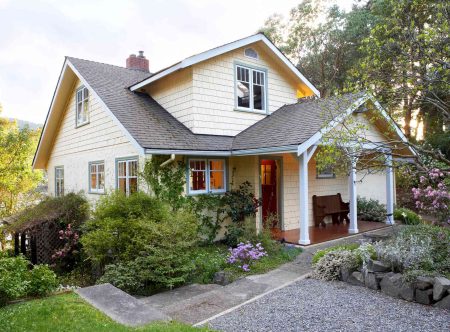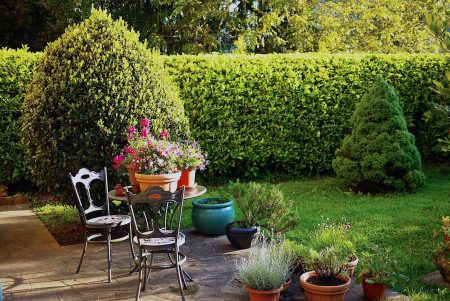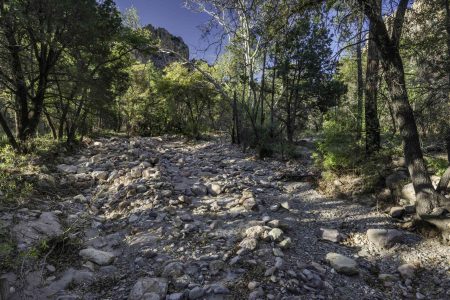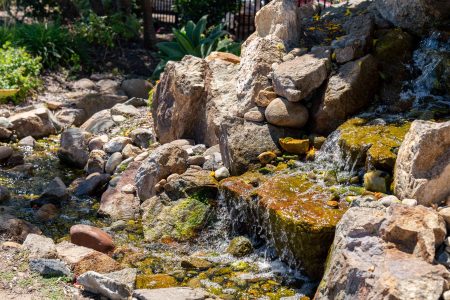Landscaping transforms your home’s exterior into a beautiful space everyone can enjoy. Well-designed landscaping ties the house to the outdoors for a cohesive, harmonious property. Landscaping is often well worth the cost, too. An overall landscape upgrade or even smaller projects like yard maintenance or lawn service can pay for themselves upon sale of the house.
Landscaping costs $2,600 on the low end for a simple garden refresh and $13,700 on the high end for a complete overhaul. The average cost of landscaping is about $8,150.
The cost of landscaping varies according to the size of the space, the materials used, and the type of landscaping project. Whether you hire professional landscapers or if you do some of the work yourself also has a bearing on the cost of the landscaping.
Landscaping Cost Per Square Foot
Determining the cost of landscaping per square foot is valuable to get a general sense of the overall cost of the project. You can expect landscaping to cost from $4 to $17 per square foot. The average cost of landscaping per square foot is around $11 per square foot.
Most residential properties are 0.2 acre or over 8,000 square feet, excluding the house. Keep in mind that not all of the property may be landscaped.
| Area Landscaped | Cost |
| 250 square feet | $3,250 |
| 500 square feet | $5,500 |
| 750 square feet | $8,250 |
| 1,000 square feet | $11,000 |
Landscaping Cost Per Hour
Determining the cost of landscaping per hour is helpful when comparing quotes from landscapers or when hiring labor for DIY work.
Labor costs for physical landscaping range from $50 to $100 per hour, with an average of about $75 per hour. Trained landscape designers generally charge about $100 or more per hour.
Cost of Landscaping Projects
The cost of landscaping projects varies widely. Simple tasks like lawn mowing cost around $90, with complex projects like retaining wall installation costing around $5,000.
- Gravel installation: $990
- Landscape curbing: $1,475
- Landscape design: $4,500
- Lawn aeration: $865
- Lawn grading: $2,000
- Lawn mowing: $90
- Lawn seeding: $992
- Mulching: $137
- Pond installation: $4,625
- Retaining wall: $5,060
- Sod installation: $2,000
- Sprinkler installation: $3,500
- Tree trimming: $580
- Water fountain: $2,750
Cost of Landscaping Materials
Landscaping materials, on the whole, are inexpensive on a square foot or cubic foot basis. However, the amount of landscaping materials needed can be so great that total costs are high.
| Material | Cost |
| Lawn turf | $12.50 per square foot |
| Lawn replacement | $1.50 per square foot |
| Mulch | $90 per cubic yard |
Landscaping Rocks and Masonry Costs
Rocks and masonry add both practical and aesthetic value to landscaping projects. As hardscaping, rocks and masonry create pathways, patios, retaining walls, and steps. They prevent soil from washing away.
Retaining walls made of masonry stabilize slopes and prevent erosion. Strategically placed rocks or gravel improve drainage in areas where water accumulates.
Rocks and masonry add aesthetic appeal to a yard’s landscape. Rock is often used as an interesting visual counterbalance to the yard’s foliage. A flagstone walkway leads visitors through the landscape or up to the home’s entrance. Natural stone is sometimes used on garden pond perimeters or to line garden beds.
| Material | Low Cost | High Cost | Average Cost |
| Boulders | $100/ton | $600/ton | $350/ton |
| Crushed stone | $1 square foot | $2 square foot | $1.50 square foot |
| Stone steps | $100/step | $300/step | $400/step |
| River rocks | $100/ton | $800/ton | $450/ton |
Cost of Landscaping, by Type
All landscaping projects can be divided into three types: softscaping, hardscaping, and xeriscaping.
- Softscaping: Softscaping involves planting shrubs, trees, flowers, grass, and other organic materials. Expect to pay about $800 to $10,000 for softscaping, with an average cost of softscaping at about $5,400.
- Hardscaping: Hardscaping refers to any work involving non-organic materials like patios, walkways, pergolas, retaining walls, and drainage systems. Hardscaping costs from $1,000 to $24,000, for an average of $12,500.
- Xeriscaping: A combination of softscaping and hardscaping, xeriscaping is used in hot climates to conserve water. Expect to pay from $13,800 to $19,000 for xeriscaping.
Landscaping Maintenance Costs
Landscaping maintenance costs, in general, range from $165 to $375 based on the size of the yard and the work required.
All types of landscaping require regular maintenance. Hardscaping tends to need less maintenance. Stone walkways, patios, and pergolas need the occasional cleaning or painting. High-maintenance areas of landscaping like lawns, flower beds, and garden ponds require more frequent visits from professionals.
7 Ways to Save Money on Landscaping Costs
Develop a Plan
Design the landscaping carefully to pare labor costs to a minimum and avoid waste. The landscape design should address both immediate needs as well as its long-term appearance.
Work With a Designer
A landscape professional, such as a landscape designer or qualified contractor or architect, will cost an average of $100 per hour ($50 at the low end and $150 at the high end). Paying for design work can save you money by developing an efficient, economical landscaping plan.
Do Some Work Yourself
Much of landscaping is DIY-friendly. Laying mulch, cutting or overseeding the lawn, installing low-voltage landscape lighting, or spreading gravel are simple projects that can save money on professional work.
Start Plants Young
Plant less expensive young plants early on to save money over more expensive mature plants. For example, emerald green arborvitae, a thick evergreen used for privacy, starts at around $20 to $25 for plants up to 2 feet tall. Costs rise exponentially with the height. A plant three times that height costs as much as ten times more.
Reuse Materials
Materials removed during landscaping can often be reused in other areas of the yard. Turf removed for walkways can be shifted to patchy areas of the lawn. Sun-faded mulch that’s still in relatively good shape can be spread to less visible parts of the yard.
Work With Existing Trees
Trees are difficult and expensive to remove. Wherever possible, incorporate existing trees into the overall landscaping plan to control costs.
Buy During the Off-Season
Gardening tools and materials are often steeply discounted after prime growing seasons. Look for sales on tomato cages, pots, gloves, and lawn edging just before the off-season. Compost, mulch, and potting soil can be stored during the winter, as long as they are kept dry. Certain plants can even be overwintered in pots: begonias, hibiscus, ferns, and geraniums, and more.
-
Is it cheaper to do landscaping yourself?
It will usually be cheaper to do landscaping by yourself. Money that would have been spent on labor or design work can be diverted back into the landscaping project or it can be saved for other uses. But doing the landscaping by yourself will not be cheaper for projects that require an excessive amount of time and labor or for projects that require rental machinery such as tillers, plate compactors, or chainsaws.
-
What is a reasonable budget for landscaping?
Landscaping costs $2,600 on the low end and about $8,150 on average. A reasonable budget for landscaping is one that fits comfortably within your home improvement and maintenance budget. Most landscaping projects should not take precedence over repairs that relate to safety or critical home maintenance like stair or deck repairs, roofing and siding, or windows and doors.
-
What is the cheapest type of landscaping?
Mulch is a lightweight material that can be used to cover large areas. Mulch is more than just a ground cover: it locks in moisture and adds nutrients to the soil to enhance plant health. Perennials eliminate the need to plant new flowers before every growing season. Rocks and masonry come with a higher initial cost but they help reduce long-term maintenance costs.
-
Is it worthwhile to hire a landscaper?
It is often worthwhile to hire a landscaper, especially when it comes to projects that require lots of physical labor such as moving or felling trees, rolling out turf, setting boulders, or digging ponds. A landscaper can also provide valuable expertise. It may not be worthwhile to hire a landscaper if you are capable and have ample time for projects like spreading mulch, cutting the lawn, or trimming trees.
Read the full article here



